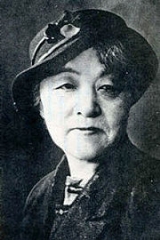
Kiyohara Tama
Encyclopedia
also known as , , or was a Japanese painter who spent most of her life in the Sicilian city of Palermo. Her maiden name was .
temple in Shiba-Shinbori, Minato, Tokyo
, Japan. She started studying seriously painting with a Japanese master even before entering elementary school. Her life suddenly changed when Sicilian sculptor Vincenzo Ragusa
, for whom she had modeled when she was just 17, after spending six years in Japan as a sculpture professor decided to go home in 1882 bringing with him Kiyohara Einosuke, his wife and 21-year-old Tamayo.
In Palermo Ragusa opened the Scuola Superiore d'Arte Applicata, employing Kiyohara and his wife as instructors to introduce Japanese lacquer techniques to Italy, but difficulties in obtaining the necessary raw materials caused the school's closure, and Kiyohara and his wife returned to Japan after six years in Palermo. They left behind their daughter Tamayo, who married Ragusa in 1889 and adopted the Italian name of Eleonora Ragusa.
She continued to be active in the arts and was nominated vice-principal of an art school Vincenzo opened in Palermo. The school, called “Museo Artistico Industriale, Scuole Officine”, was opened in 1884 with public funds in Palazzo Belvedere (Casa Benzo). He headed the male section, she the female section. The school still exists under the name of Istituto d'Arte di Palermo.
After her husband's death in 1927, two Japanese newspapers, the Osaka Mainichi Shinbun and the Tokyo Nichinichi Shinbun, found out about her story and published a serialized novel about it, bringing Tamayo to fame in her homeland. By then she could barely speak Japanese
anymore, but she decided to go back. After her return, she opened an atelier in Shiba Shinbori, where she died some years later. She is buried at her family temple
, Chōgen-ji. Kiyohara was herself a painter of great skill, but most of the works she left in Japan were destroyed during WWII
, while those left in Italy are still exhibited in various private collections.
According to her wishes, half of her ashes are in Japan, half lie in Palermo next to her husband's grave.
Biography
Kiyohara Tamayo was the second daughter of Kiyohara Einosuke, manager of the famous Zōjō-jiZojo-ji
San'en-zan is a Buddhist temple in the Shiba neighborhood of Minato, Tokyo, Japan. It is the Great Main Temple of the Chinzai sect of the Shingon school. The main image is of Amida Buddha...
temple in Shiba-Shinbori, Minato, Tokyo
Minato, Tokyo
is one of the 23 special wards of Tokyo, Japan. As of 1 March 2008, it had an official population of 217,335 and a population density of 10,865 persons per km². The total area is 20.34 km².Minato hosts 49 embassies...
, Japan. She started studying seriously painting with a Japanese master even before entering elementary school. Her life suddenly changed when Sicilian sculptor Vincenzo Ragusa
Vincenzo Ragusa
Vincenzo Ragusa was an Italian sculptor who lived in Meiji period Japan from 1876-1882. He introduced European techniques in bronze casting, and new methods of modeling in wood, clay, plaster and wire armatures which exerted a significant role in the development of the modern Japanese sculptural...
, for whom she had modeled when she was just 17, after spending six years in Japan as a sculpture professor decided to go home in 1882 bringing with him Kiyohara Einosuke, his wife and 21-year-old Tamayo.
In Palermo Ragusa opened the Scuola Superiore d'Arte Applicata, employing Kiyohara and his wife as instructors to introduce Japanese lacquer techniques to Italy, but difficulties in obtaining the necessary raw materials caused the school's closure, and Kiyohara and his wife returned to Japan after six years in Palermo. They left behind their daughter Tamayo, who married Ragusa in 1889 and adopted the Italian name of Eleonora Ragusa.
She continued to be active in the arts and was nominated vice-principal of an art school Vincenzo opened in Palermo. The school, called “Museo Artistico Industriale, Scuole Officine”, was opened in 1884 with public funds in Palazzo Belvedere (Casa Benzo). He headed the male section, she the female section. The school still exists under the name of Istituto d'Arte di Palermo.
After her husband's death in 1927, two Japanese newspapers, the Osaka Mainichi Shinbun and the Tokyo Nichinichi Shinbun, found out about her story and published a serialized novel about it, bringing Tamayo to fame in her homeland. By then she could barely speak Japanese
Japanese language
is a language spoken by over 130 million people in Japan and in Japanese emigrant communities. It is a member of the Japonic language family, which has a number of proposed relationships with other languages, none of which has gained wide acceptance among historical linguists .Japanese is an...
anymore, but she decided to go back. After her return, she opened an atelier in Shiba Shinbori, where she died some years later. She is buried at her family temple
Bodaiji
A , in Japanese Buddhism is a temple which, generation after generation, takes care of a family's dead giving them burial and performing ceremonies in their soul's favor. The name is because in Japan the term , which originally meant just Buddhist enlightenment , has also come to mean either the...
, Chōgen-ji. Kiyohara was herself a painter of great skill, but most of the works she left in Japan were destroyed during WWII
World War II
World War II, or the Second World War , was a global conflict lasting from 1939 to 1945, involving most of the world's nations—including all of the great powers—eventually forming two opposing military alliances: the Allies and the Axis...
, while those left in Italy are still exhibited in various private collections.
According to her wishes, half of her ashes are in Japan, half lie in Palermo next to her husband's grave.

